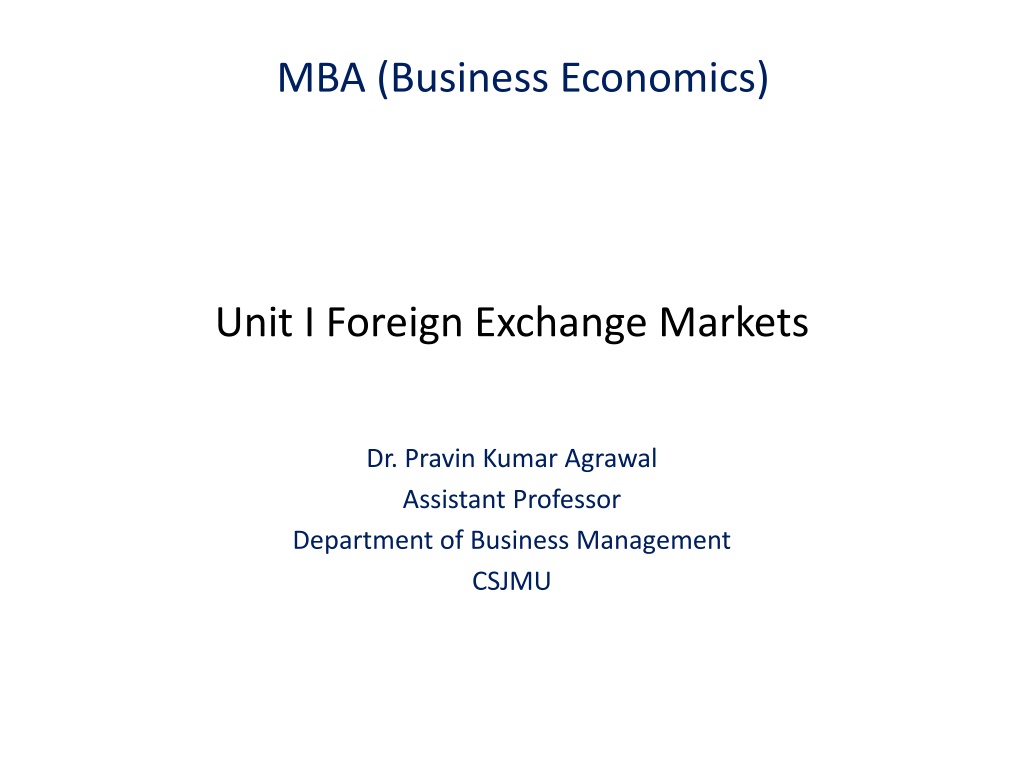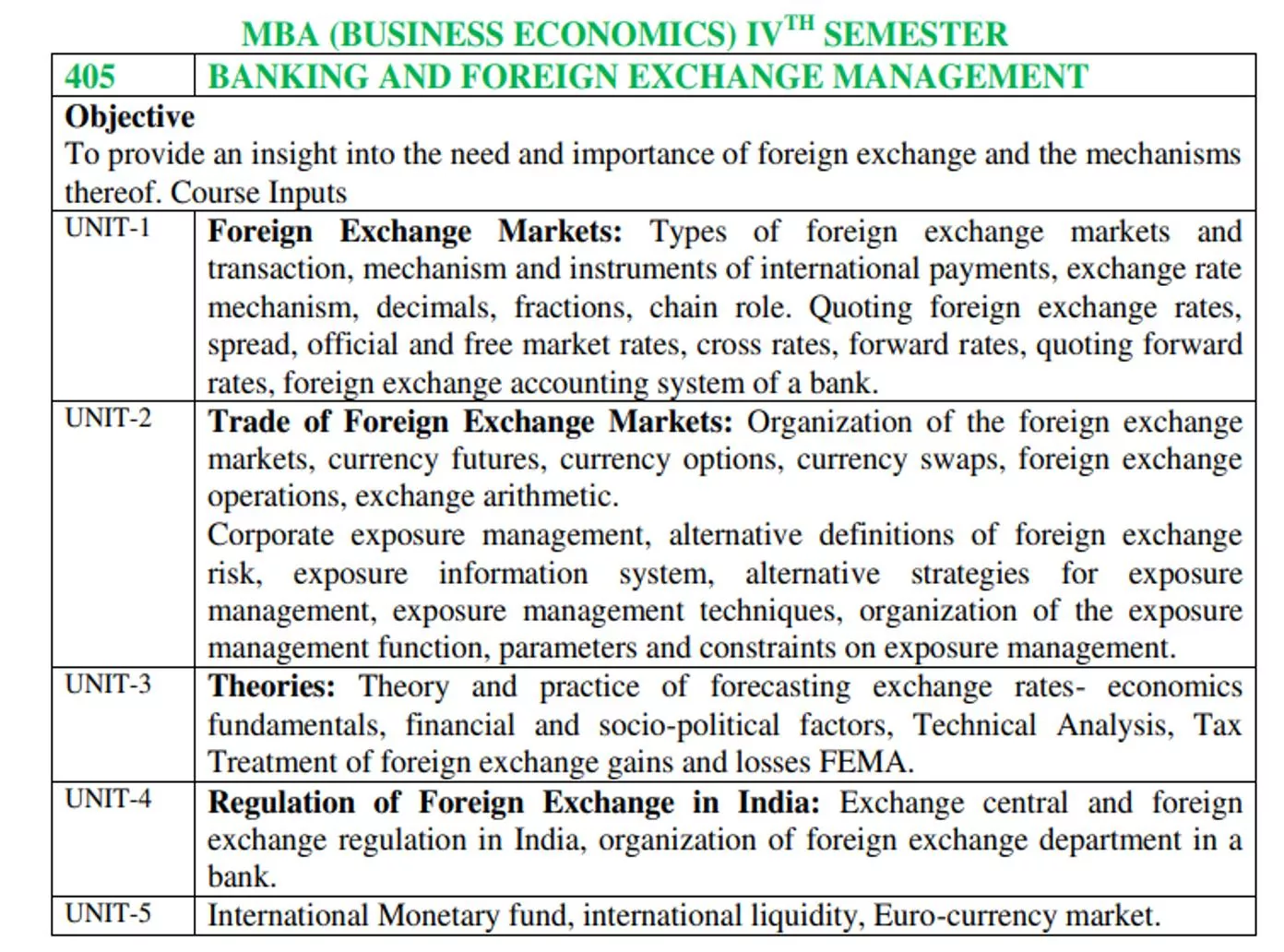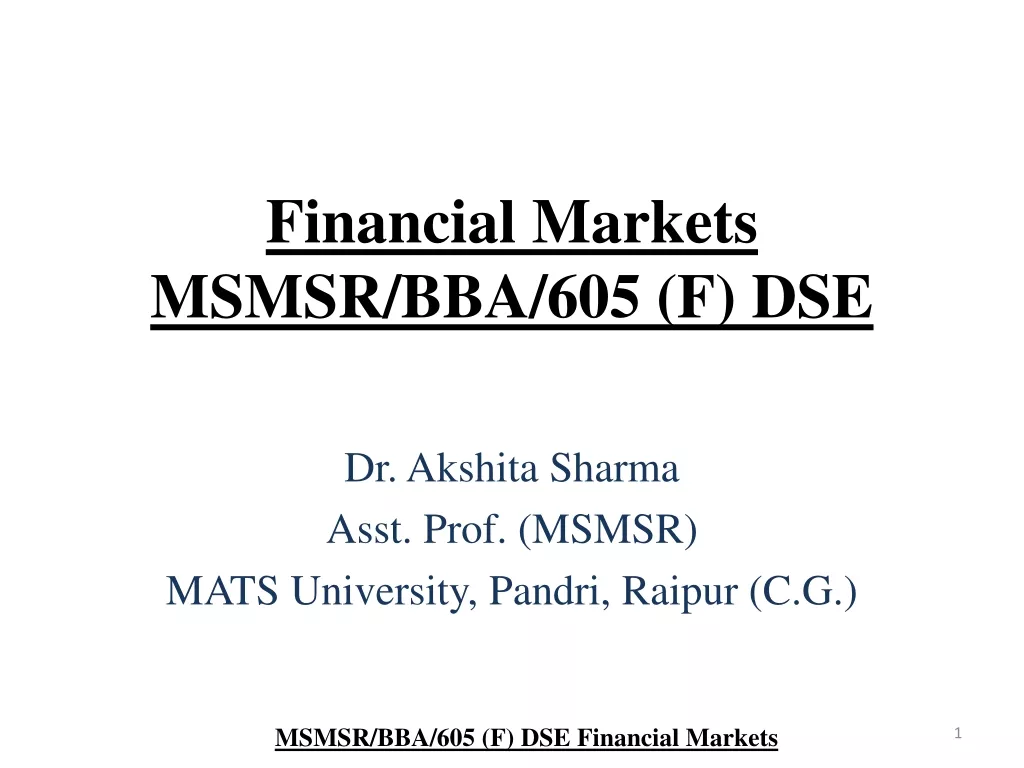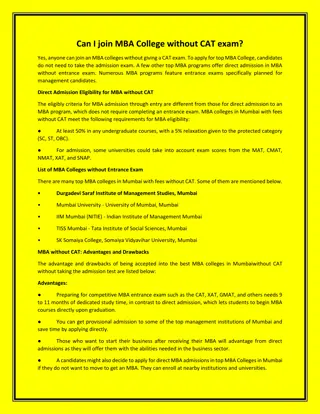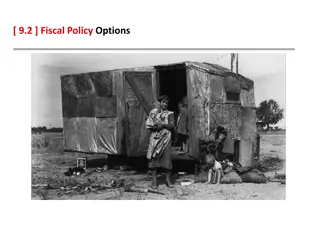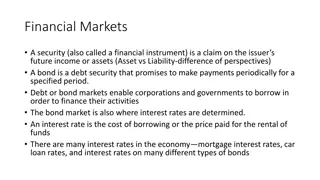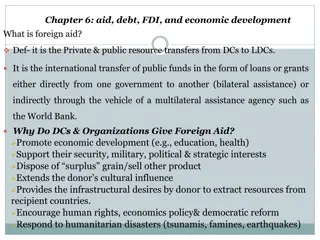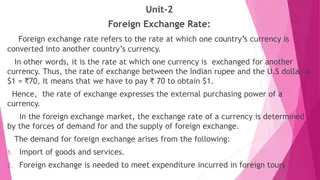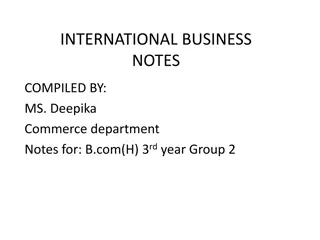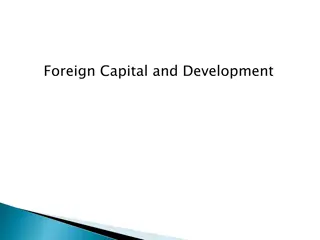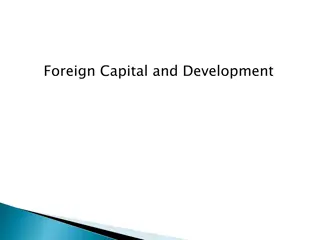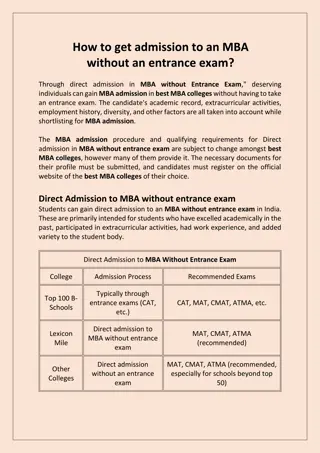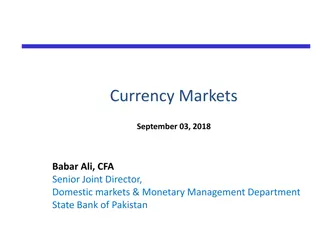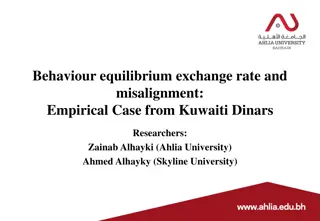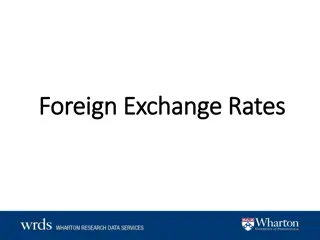MBA (Business Economics) Unit I Foreign Exchange Markets
This unit explores the dynamics of foreign exchange markets under the guidance of Assistant Professor Dr. Pravin Kumar Agrawal at CSJMU. Gain insight into the complexities of global financial systems and enhance your understanding of business management through this comprehensive course.
Download Presentation

Please find below an Image/Link to download the presentation.
The content on the website is provided AS IS for your information and personal use only. It may not be sold, licensed, or shared on other websites without obtaining consent from the author. Download presentation by click this link. If you encounter any issues during the download, it is possible that the publisher has removed the file from their server.
E N D
Presentation Transcript
MBA (Business Economics) Unit I Foreign Exchange Markets Dr. Pravin Kumar Agrawal Assistant Professor Department of Business Management CSJMU
Foreign Exchange Market Foreign exchange market is the market in which foreign currencies are bought and sold. This market is also termed as Currency, FX, or forex market. Its participant comprises of individuals, firms, commercial banks, the central banks, importers and exporters, investors, brokers, immigrants, tourists.
Foreign Exchange Market The international trade and investment by enabling currency conversion. For example, it permits a business in the India to import goods from the United States and pay dollars, even though its income is in Indian rupees. foreign exchange market assists
Characteristics of foreign exchange market High Liquidity Market Transparency Dynamic Market Lower Trading Cost Operates 24 Hours Dollar Most Widely Traded
Base Currency / Terms Currency In foreign exchange markets, the base currency is the first currency in a currency pair. The second currency is called as the terms currency. Exchange rates are quoted in per unit of the base currency. Eg. The expression US Dollar Rupee, tells you that the US Dollar is being quoted in terms of the Rupee. The US Dollar is the base currency and the Rupee is the terms currency.
Base Currency / Terms Currency Exchange rates are constantly changing, which means that the value of one currency in terms of the other is constantly in flux. Changes in rates are expressed as strengthening or weakening of one currency vis- -vis the other currency. Changes are also expressed as appreciation or depreciation of one currency in terms of the other currency. Whenever the base currency buys more of the terms currency, the base currency has strengthened / appreciated and the terms currency has weakened / depreciated. Eg. If US Dollar Rupee moved from 73.00 to 73.25, the US Dollar has appreciated and the Rupee has depreciated.
Market participates of foreign exchange Market The foreign exchange market assists international trade and investment by enabling currency conversion. For example, it permits a business in the United States to import goods from the European Union member states especially Euro zone members and pay Euros, even though its income is in United States dollars. The foreign exchange market (forex, FX, or currency market) is a form of exchange for the global decentralized trading of international currencies.
Commercial Bank These banks are the major players in the market. Commercial and investment banks are the main players of the foreign exchange market; they not only trade on their own behalf but also for their customers. A major chunk of the trade comes by trading in currencies indulged by the bank to gain from exchange movements. Interbank transaction is done in case the transaction volume is huge. For small volume intermediation of foreign exchange, a broker may be sought.
Central bank Central banks like RBI in India (RBI) intervene in the market to reduce currency fluctuations of the country currency (like INR, in India) and to ensure an exchange rate compatible with the requirements of the national economy. For example, if rupee shows signs of depreciation, RBI (central bank) may release (sell) a certain amount of foreign currency (like dollar). This increased supply of foreign currency will halt the depreciation of rupee. The reverse operation may be done to halt rupee from appreciating too much.
Foreign exchange fixing Foreign exchange fixing is the daily monetary exchange rate fixed by the national bank of each country. The idea is that central banks use the fixing time and exchange rate to evaluate behavior of their currency. Fixing exchange rates reflects the real value of equilibrium in the market. Banks, dealers and traders use fixing rates as a trend indicator.
Hedge funds as speculators About 70% to 90% of the foreign exchange transactions are speculative. In other words, the person or institution that bought or sold the currency has no plan to actually take delivery of the currency in the end; rather, they were solely speculating on the movement of that particular currency.
Investment management firms Investment management of various securities (shares, bonds and other securities) and assets (e.g., real estate) in order to meet specified investment goals for the benefit of the investors. management is the professional These firms (who typically manage large accounts on behalf of customers such as pension funds and endowments) use the foreign exchange market to facilitate transactions in foreign securities
Retail foreign exchange traders One of the most important tools required to perform a foreign exchange transaction is the trading platform providing retail traders and brokers with accurate currency quotes. Retail foreign exchange trading is a small segment of the large foreign exchange market.
Functions of Foreign Exchange Market Transfer Function The basic and the most obvious function of the foreign exchange market is to transfer the funds or the foreign currencies from one country to another for settling their payments. The market basically converts one s currency to another.
Credit Function It provides credit for foreign trade. Bills of exchange, with maturity period of three months, are generally used for international payments. Credit is required for this period in order to enable the importer to take possession of goods, sell them and obtain money to pay off the bill.
Hedging Function A third function of the foreign exchange market is to hedge foreign exchange risks. Hedging means the avoidance of a foreign exchange risk. In a free exchange market when exchange rate, i. e., the price of one currency in terms of another currency, change, there may be a gain or loss to the party concerned. Under this condition, a person or a firm undertakes a great exchange risk if there are huge amounts of net claims or net liabilities which are to be met in foreign money. Exchange risk as such should be avoided or reduced. For this the exchange market provides facilities for hedging anticipated or actual claims or liabilities through forward contracts in exchange.
Hedging Function A forward contract which is normally for three months is a contract to buy or sell foreign exchange against another currency at some fixed date in the future at a price agreed upon now. No money passes at the time of the contract. But the contract makes it possible to ignore any likely changes in exchange rate. The existence of a forward market thus makes it possible to hedge an exchange position.
Minimizing Foreign Exchange Risk The foreign exchange market provides "hedging" facilities for transferring foreign exchange risk to someone else. Thus, the foreign exchange market is merely a part of the money market in the financial centers. It is a place where foreign moneys are bought and sold. The buyers and sellers of claim on foreign money and the intermediaries together constitute a foreign exchange market. It is not restricted to any given country or a geographical area.
Spot market Spot market refers to the transactions involving sale and purchase of currencies for immediate delivery. In practice, it may take T+2 business days to settle transactions. Transactions are affected at prevailing rate of exchange at that point of time and delivery of foreign exchange is affected instantly. The exchange rate that prevails in the spot market for foreign exchange is called Spot Rate.
Forward Market A market in which foreign exchange is bought and sold for future delivery is known as Forward Market. It deals with transactions (sale and purchase of foreign exchange) which are contracted today but implemented sometimes in future. Exchange rate that prevails in a forward contract for purchase or sale of foreign exchange is called Forward Rate. Thus, forward rate is the rate at which a future contract for foreign currency is made.
Forward Transaction A forward transaction is a future transaction where the buyer and seller enter into an agreement of sale and purchase of currency after 90 days of the deal at a fixed exchange rate on a definite date in the future. The rate at which the currency is exchanged is called a Forward Exchange Rate . The market in which the deals for the sale and purchase of currency at some future date are made is called a Forward Market .
Future Market Standardized forward contracts are called futures contracts and traded on a futures exchange. A futures contract is a standardized contract between two parties to buy or sell a specified asset of standardized quantity and quality for a price agreed upon today (the futures price or strike price) with delivery and payment occurring at a specified future date.
Future Transaction The future transactions are also the forward transactions and deals with the contracts in the same manner as that of normal forward transactions. But however, the transactions made in a future contract differ from the transaction made in the forward contract on the following grounds: The forward contracts can be customized on the client s request, while the future contracts are standardized such as the features, date, and the size of the contracts is standardized. The future contracts can only be traded on the organized exchanges, while the forward contracts can be traded anywhere depending on the client s convenience. No margin is required in case of the forward contracts, while the margins are required of all the participants and an initial margin is kept as collateral so as to establish the future position.
Option Market A currency option gives an investor the right, but not the obligation, to buy or sell a quantity of currency at a pre-established price on or before the date that the option expires. The right to sell a currency is known as a put option" and the right to buy is known as a call option.
Example An option to buy US Dollar ($) for Indian Rupees (INR, base currency) is a USD call and an INR put. The symbol for this will be USDINR or USD/INR. Conversely, an option to sell USD for INR is a USD put and an INR call. The symbol for this trade will be like INRUSD or INR/USD.
SWAP A currency swap is an agreement in which two parties exchange the principal amount of a loan and the interest in one currency for the principal and interest in another currency. At the inception of the swap, the equivalent principal amounts are exchanged at the spot rate. During the length of the swap each party pays the interest on the swapped principal loan amount.
SWAP.. At the end of the swap the principal amounts are swapped back at either the prevailing spot rate, or at a pre-agreed rate such as the rate of the original exchange of principals. Using the original rate would remove transaction risk on the swap. Currency swaps are used to obtain foreign currency loans at a better interest rate than a company could obtain by borrowing directly in a foreign market or as a method of hedging transaction risk on foreign currency loans which it has already taken out.
Fixed for Fixed currency swap An American company may be able to borrow in the United States at a rate of 6%, but requires a loan in Indian Rupees for an investment in India, where the relevant borrowing rate is 9%. At the same time, an Indian company wishes to finance a project in the United States, where its direct borrowing rate is 11%, compared to a borrowing rate of 8% in India.
Example RBI signs $400 million currency swap pact with Central Bank of Sri Lanka: The Reserve Bank of India (RBI) has signed a currency swap agreement with the Central Bank of Sri Lanka, the central bank said on Monday. The Central Bank of Sri Lanka can make drawals of US Dollar, Euro or Indian Rupee in multiple tranches up to a maximum of USD 400 million or its equivalent under a currency swap agreement, the RBI said in a release. The agreement signed under the SAARC Currency Swap Framework 2019- 22 would be valid till November 13, 2022. Source: https://economictimes.indiatimes.com/markets/forex/rbi-signs-400-million-currency-swap-pact-with-central-bank-of-sri-lanka/articleshow/77201835.cms?from=mdr
Exchange Rate Mechanism ForeignExchange refers to money denominated in the currency of another nation or a group of nations. Any person who exchanges money denominated in his own nation s currency for money denominated in another nation s currency acquires foreign exchange.
Exchange Rate Mechanism This holds true whether the amount of the transaction is equal to a few rupees or to billions of rupees; whether the person involved is a tourist or an investor exchanging hundreds of millions of rupees for the acquisition of a foreign company; and whether the form of money being acquired is foreign currency notes, foreign currency-denominated bank deposits, or other short-term claims denominated in foreign currency.
Exchange Rate Mechanism A foreign exchange transaction is still a shift of funds or short-term financial claims from one country and currency to another. Thus, within India, any money denominated in any currency other than the Indian Rupees (INR) is, broadly speaking, foreign exchange.
Exchange Rate Mechanism Almost every nation has its own national currency or monetary unit - Rupee, US Dollar, Peso etc.- used for making and receiving payments within its own borders. But foreign currencies are usually needed for payments across national borders. Thus, in any nation whose residents conduct business abroad or engage in financial transactions with persons in other countries, there must be a mechanism for providing access to foreign currencies, so that payments can be made in a form acceptable to foreigners. In other words, there is need for foreignexchange transactions exchange of one currency for another.
Exchange Rate Mechanism The market price is determined by the interaction of buyers and sellers in that market, and a market exchange rate between two currencies is determined by the interaction of the official and private participants in the foreign exchange rate market. For a currency with an exchange rate that is fixed, or set by the monetary authorities, the central bank or another official body is a participant in the market, standing ready to buy or sell the currency as necessary to maintain the authorized pegged rate or range. But in countries like the United States, which follows a complete free floating regime, the authorities are not known to intervene in the foreign exchange market on a continuous basis to influence the exchange rate. The market participation is made up of individuals, non-financial firms, banks, official bodies, and other private institutions from all over the world that are buying and selling US Dollars at that particular time.
Exchange Rate Mechanism The participants in the foreign exchange market are thus a heterogeneous group. The various investors, hedgers, and speculators may be focused on any time period, from a few minutes to several years. But, whatever is the constitution of participants, and whether their motive is investing, hedging, speculating, arbitraging, paying for imports, or seeking to influence the rate, they are all part of the aggregate demand for and supply of the currencies involved, and they all play a role in determining the market price at that instant. Given the diverse views, interests, and time frames of the participants, predicting the future course of exchange rates is a particularly complex and uncertain exercise.
MAJOR CURRENCIES OF THE WORLD US Dollar ($) The Euro ( ) The Japanese Yen ( )
Quoting foreign Exchange Rates The ratio between 2 currencies is called exchange rate.
Direct Quotes The home currency price of a certain amount of a foreign currency eg. INR 45 / USD
Indirect Quotes The value of one unit of home currency is presented in terms of Foreign Currency. USD 0.02857/INR
Numerical If the direct quote is INR 63/USD, then how can this exchange rate be presented in Indirect quotes.
Exchange Rate An exchange rate between two currencies is the rate at which one currency can be exchanged for another. Exchange rates can be either fixed or floating. Fixed exchange rates are decided by central banks of a country whereas floating exchange rates are decided by the mechanism of market demand and supply.
Example In February 2, 2022, one USD was equal to 76.92 Rs., and one Indian ruppes was equal to 0.013 USD.
Bid" and Ask" The terms "bid" and "ask" refer to price quotes. The bid price is the highest amount a buyer is willing to pay for a security, such as a share of a stock. The ask price is the least amount the seller is willing to accept for that security. The bid is the price at which the market will buy a currency pair (before any commissions or fees), the offer (or ask) is the price at which the market will sell the currency pair (before any commissions or fees).
For example, a USDCAD exchange rate of 0.9950 means that 1 USD will return .9950 CAD.
For example, with USDINR, one would buy USD from the customer on the bid, thereby selling them INR. Alternatively, one would sell (or offer) the unit currency, USD, on the offer and buy the second currency (INR).
Example An Indian company needs to purchase 100,000 US dollars to pay for imported goods. The USDINR quoted rate is 76.25 on the bid and 76.45 on the offer. By convention the USD is the unit currency and INR is the terms currency. The company will have to buy the USD on the dealer's offer, and will pay 76.45 for each dollar bought. The importer pays 100,000 x 76.45= 7645000 INR.
Spread Buying Rate is known as Bid rate Selling rate is known as ask/offer rate. Bid rate = rate at which bank purchase foreign currency from customers Ask rate = rate at which bank sell foreign currency to customers The difference is banks profit known as spread. It would be written as Rs. 40 40.30/USD Eg. Bid rate = Rs. 40 Ask rate 40.30 for customers
